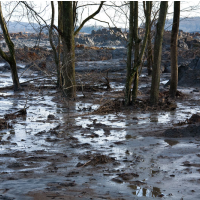Judge Tries to Force EPA to Regulate Coal Ash
 Tennessee coal ash spill (photo: Jerry Greer)
Tennessee coal ash spill (photo: Jerry Greer)
How much time does the U.S. Environmental Protection Agency (EPA) need to do its job? Federal Judge Reggie Walton issued an order on Tuesday to find out whether EPA’s multi-year failure to issue sorely needed coal ash regulations means the agency is ready to act after a needed push. Walton, who tries cases filed in the District of Columbia, gave the agency that push on September 30 when he ruled in favor of Earthjustice and 10 other groups in a lawsuit they filed against the EPA over its regulatory inaction.
Coal ash, a euphemism for the solid waste produced by coal-burning power plants, contains arsenic, barium, boron, beryllium, cadmium, chromium, lead, mercury, molybdenum, nickel, selenium and thallium, which have been linked to cancer, birth defects, digestive illnesses, reproductive conditions, and other health problems. About 600 U.S. power plants generate 136 million tons of it every year, which they dump in about 1,160 ponds, landfills and mine shafts being used for temporary disposal. Coal ash has polluted groundwater and/or surface water at no fewer than 156 sites in 34 states.
In Tuesday’s order, Walton gave EPA 60 days to file “a proposed deadline for its compliance with its obligation to review and revise if necessary…regulations concerning coal ash.” EPA, which has not reviewed its coal ash rules since 2000 nor revised them since 1981, presented two proposals in June 2010. One plan would classify it as “hazardous” and the other as “non-hazardous,” but the agency has yet to make a choice three years later.
EPA also issued draft risk assessments on the management of coal ash in 2007 and 2010, and three reports regarding the increasing toxicity of coal ash from 2006 to 2009. The 2010 peer-reviewed report found that people living near some unlined coal ash ponds have a one in fifty risk of cancer from drinking arsenic-contaminated water—2,000 times higher than EPA’s regulatory goal. The consequences of coal ash have also been covered by the Center for Public Integrity in a series of stories.
In Tuesday’s decision, Walton decided that federal law requires EPA to review and, if necessary, revise rules every three years. “The language is unambiguous in its command and contains no limitation ending the EPA’s obligation to undertake such reviews and revisions at least every three years,” wrote Walton.
Environmental advocates praised the ruling as a victory, even though all it does is force EPA to issue a schedule for making its decision, and says nothing about the substance of any new regulations. “The court is saying to EPA, ‘Put forward a schedule for making a final decision,’” said Lisa Evans of Earthjustice. Given the ten-year delay, it is understandable that this feels like a victory.
-Matt Bewig
To Learn More:
EPA under the Gun to Regulate Coal Ash (by Kristen Lombardi, Center for Public Integrity)
Exasperated by EPA Inaction, Residents near Coal Ash Dumps File Lawsuits (by Noel Brinkerhoff and David Wallechinsky, AllGov)
EPA Sued over Refusal to Regulate Coal Ash (by Matt Bewig, AllGov)
- Top Stories
- Unusual News
- Where is the Money Going?
- Controversies
- U.S. and the World
- Appointments and Resignations
- Latest News
- Trump to Stop Deportations If…
- Trump Denounces World Series
- What If China Invaded the United States?
- Donald Trump Has a Mental Health Problem and It Has a Name
- Trump Goes on Renaming Frenzy






Comments